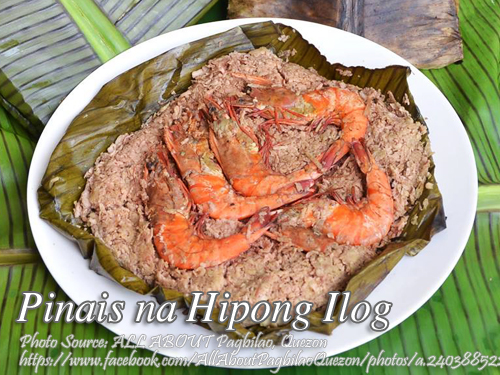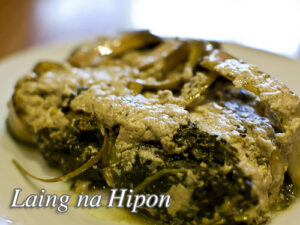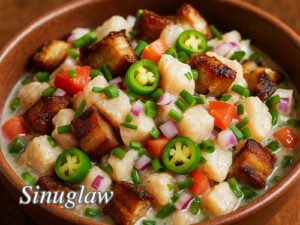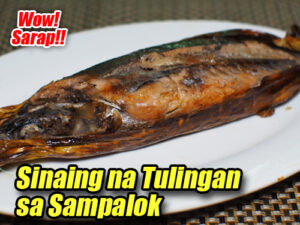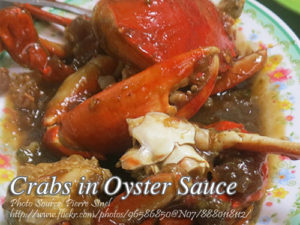This pinais na hipon is a native delicacy which is probably from the province of Quezon. It is made of fresh water shrimps combined with grated young coconut, salt and pepper then wrapped in banana leaves. It is then cooked by boiling it on coconut water. It is then broiled on charcoal until the banana leaves are slightly burned. Fresh water shrimps are abundant in places near Laguna de Bay. Those shrimps looks like a crayfish because they have claws but the claws are slender. Just in case you can’t find fresh water shrimps, you can use saltwater shrimps or small prawns.
Pinais na Hipon: A Taste of Quezon’s Coastal Heritage
Pinais na Hipon is one of those dishes that transport me straight back to warm summer afternoons in my uncle Lando’s bahay kubo in Quezon. The scent of banana leaves gently charring over live charcoal, mixed with the briny freshness of shrimp, still makes my mouth water just thinking about it. It’s a dish deeply rooted in the province’s rich culinary heritage, where coconut trees and the nearby waters of Laguna de Bay provide an abundance of natural ingredients.
This native delicacy speaks volumes about simple but vibrant Filipino cooking. The magic lies in the combination of sweet, young coconut meat, freshly caught shrimp, and the unmistakable aroma of banana leaves cooked over a traditional open flame. And though pinais na hipon sounds fancy, it’s a relatively straightforward recipe even beginners can master.
A Family Tradition by the Seaside
I remember one summer, my cousin Jessa came back from her studies in Manila and decided to give the city life a break. She brought with her a craving for authentic home-cooked meals, and of course, my grandmother couldn’t disappoint. As the sun was setting and the air began to cool, Lola Nida prepared this very dish, filling our humble kitchen with the fragrant smell of coconut water boiling and banana leaves sizzling.
Jessa and I were tasked with cleaning the fresh water shrimps my uncle had caught earlier that day near Laguna de Bay. Freshwater shrimps, locally known as ulang, have slender claws and a crayfish-like appearance. They’re slightly sweet and have a more robust flavor compared to their saltwater cousins, making them perfect for this dish. But in case you can’t find these local delicacies, small prawns or saltwater shrimp work well too.
Preparing Pinais na Hipon Freshest Ingredients
The secret to a perfect pinais na hipon is the quality of your ingredients. Grated buko, or young coconut, is essential because of its soft texture and mild sweetness. My grandmother always stressed using buko rather than mature coconut meat, as the latter would be too tough and fibrous. The coconut’s freshness adds a creamy depth to the dish, enhancing the natural flavors of the shrimp. Salt and pepper are all you need to season, keeping everything simple yet incredibly flavorful.
We would divide the shrimp mixture into portions, carefully wrapping each in banana leaves, just as my grandmother taught us. Wrapping it well ensures that the coconut and shrimp flavors are sealed in as they cook. If you’re using banana leaves for the first time, don’t worry if you don’t get it right away. My auntie Melba would laugh at our awkward attempts but always reminded us that cooking from the heart was more important than perfect wrapping skills.
Cooking Techniques Passed Down Through Generations
Boiling the shrimp parcels in coconut water is a technique that may seem curious at first. But trust me, there’s a reason behind it. The coconut water infuses the shrimp with a subtle, sweet essence, while also keeping them tender and juicy. Coconut water, unlike plain water, acts as a natural flavor enhancer. As the shrimp cook, the liquid reduces, concentrating those delicate, sweet flavors.
Once boiled, the pinais parcels are cooled and then broiled over live charcoal. This step is crucial because it caramelizes the banana leaves and lends a smoky, earthy aroma to the dish. If you’re in a modern kitchen without access to charcoal, you can use a preheated oven to achieve a similar effect. But there’s something special about the rustic, slightly charred flavor from cooking over coals, reminiscent of warm evenings spent with family, laughter filling the air.
History on a Plate
Pinais na hipon may have humble ingredients, but it’s a dish that carries centuries of coastal tradition. Its roots likely trace back to when locals found inventive ways to cook their daily catch using natural materials. Banana leaves were the perfect solution: they were abundant, eco-friendly, and imparted a distinct fragrance to the food. Plus, they kept the dish moist and tender without the need for added fats or oils.
When my brother Arnel traveled to Bicol, he noticed that a similar method was used for pinais, but with different ingredients like fish and taro leaves. Regional adaptations across the Philippines highlight the versatility of this cooking technique, making pinais not just a recipe but a celebration of our rich and diverse food culture.
The Perfect Meal to Share
Serving pinais na hipon always feels special. Once you unwrap the banana leaves, the aroma hits you, a mix of smoky, savory, and sweet. My family enjoys this dish best when served hot, with steaming rice and maybe a side of fresh tomatoes and salted egg. The flavors are simple but oh-so-satisfying, a true testament to the Filipino way of making the most out of what nature provides.
So, if you find yourself craving something uniquely Filipino, give this recipe a try. Even if you’re far from the coastal towns of Quezon, a taste of pinais na hipon might just bring the essence of those sunny shores to your kitchen. Who knows, maybe you’ll create your own special family memories along the way.
How to Cook Pinais na Hipong Ilog
Ingredients
- 1/2 kilo fresh water shrimps (hipong ilog)
- 2 cups young coconut buko, grated
- 2 tsp. salt
- 1/2 tsp. black pepper ground
- 2 pcs wilted banana leaves
- 2 pcs banana leaves
- 2 cups buko water
Instructions
How to cook Pinais na Hipong Ilog:
- Wash shrimps very well.Trim heads. Combine with grated buko, salt and pepper.
- Divide mixture into 6 portions. Place 1 portion of mixture in banana leaf.
- Top with 1 or 2 banana leaves.Wrap and secure with string. Do the same for the remaining ingredients.
- Arrange wrapped shrimp mixture in a saucepan. Pour buko water. Boil until shrimps are cooked.
- Drain from broth. Let cool and dry. Put each wrapped shrimp over live charcoal and broil until banana leaves are partially burned or broil in preheated oven.
- Unwrap and serve hot. Serves 6.
Notes
Cooking Tips:
Use Fresh Ingredients for Maximum Flavor
To ensure the best taste, use fresh shrimp and young coconut. Fresh shrimp will have a sweeter, more delicate flavor compared to frozen ones, and grated buko adds a subtle creaminess that mature coconut cannot replicate. Always check for signs of freshness, like firm texture and a mild ocean scent, to elevate your dish.Soften Banana Leaves Before Wrapping
Banana leaves are easier to work with if you briefly pass them over an open flame or blanch them in hot water. This technique makes the leaves more pliable, reducing the risk of tearing while wrapping the shrimp mixture. Plus, it brings out the natural aroma of the banana leaves, adding depth to the final dish.Don’t Skip the Charcoal Broiling
Broiling over live charcoal imparts a smoky, earthy flavor that makes pinais na hipon unforgettable. If you’re tempted to skip this step and just use the oven, consider that the unique aroma from the charring banana leaves is a crucial part of the dish’s authentic taste. Even if using a grill pan indoors, try to mimic that smoky effect as much as possible.
